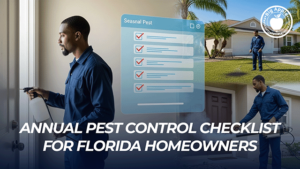The pest control industry is poised for a significant evolution as we approach 2025. Rapid technological advancements, increasing environmental concerns, and rising demand for sustainable solutions promise to reshape how pests are managed globally. This blog dives into the key trends, innovations, and consumer expectations defining the industry’s future in 2025.
Future of Pest Control Industry 2025

Growing Demand for Eco-Friendly Solutions
As ecological consciousness increases, consumers and corporations emphasize eco-friendly pest management techniques. By 2025, the search for non-toxic and chemical-free alternatives that guarantee the safety of humans, pets, and the planet will reach unparalleled levels. The environment will favor renewable solutions and bio-pest control tactics, like utilizing beneficial insects to outcompete harmful pests.
Businesses will respond to this pressure by launching intensive research and developing greener products. The trend towards environmental sustainability is not merely a fad but is swiftly being adopted as the standard for customers. The pest control companies that do not refocus on this area to innovate will likely become obsolete.
Integration of Smart Technology
Innovative technology is a game-changer in the pest control industry, as it is evolving faster. By 2025, pest detection and control will occur through the Internet of Things (IoT) devices, accomplished with the utmost precision. The sensors can monitor pest activity in real time while notifying relevant parties when the population size crosses critical limits.
Apart from cutting costs for service providers and customers, AI-enabled platforms will also improve predictive analytics by providing solutions to potential infestations before they occur. These technologies increase efficiency and become the standard for the commercial property sector, with many homeowners adopting them.
Rise of Urban Pest Control Services
The push towards urbanization is still on the rise, and along with megacities come colossal challenges associated with pest control. By 2025, pest management will be almost entirely concentrate in urban areas, emphasizing issues such as rats in the sewers or insects in high-rises.
For urban pest control, we will employ advanced techniques that also consider the peculiarities of the human-made environment. Therefore, the use of drones for monitoring shelves and automated traps will be widespread soon. The businesses that operate in the field of urban pest control are going to be the gurus of the industry of the future as cities like this become more prominent and more populated.
Growth in Organic and DIY Solutions
Consumers are increasingly focusing on sustainable and DIY approaches to pest control. It is estimate that the use of organic pesticides, natural repellents, and various other methods will grow by 2025. People are learning more about pest control and prefer safer, do-it-yourself approaches, especially for minor infestations.
This offers the pest control companies a dual chance and challenge. They can expand the reach of their offerings by using organic materials and creating easy-to-follow instructions for people to deal with small pest infestations at home. Companies that produce valuable information and tools will build trust with their clients and have greater brand loyalty.
Increased Regulatory Oversight
Governments and regulatory bodies are tightening the screws on the use of harmful chemicals in pest management. By 2025, the industry will be force to operate in a completely new way due to stricter regulations on the composition, application, and disposal of pesticides. Suppliers will be required to follow newly established environmental and safety standards.
This shift will likely decrease broad-spectrum chemicals and increase the selection of targeted solutions with fewer side effects. Pest control providers must comply with these regulations to proceed financially and gain their customers’ trust.
Challenges of Climate Change
The effect of climate change will persist as a driving factor in the behavior and population of pests by 2025. The recent increase in global temperatures and changing rainfall patterns expected to widen the range of several pests, such as mosquitoes and termites, thus causing the most demand for pest control services in parts of the world that have not had this problem before.
To successfully tackle these issues, pest control service providers must continue their research and devise new counterstrategies. An organization’s most important goals are to be flexible in its services and use the latest technology properly to face the most unpredictable environmental situations concerning pests.
The Role of Education and Training
Due to the development of cutting-edge technologies and changing regulations, a growing need for professional pest control experts is predict in 2025. Companies will emerge more potent by increasing their investments and training their employees in new technologies, eco-friendly methodologies, and customer service skills.
In addition, the industry will likely see an increased focus on certifications and accreditations as customers look for assurance of the organization’s quality and professionalism. The firms that prioritize education and training will become the torchbearers in the future of pest control.
Conclusion
The main determinants of the pest control industry in 2025 will be more brilliant technology, eco-friendly practices, and customized solutions. Businesses that adjust to these trends will surely be in the best place to flourish in such a competitive and changing market.
If you are in the pest control industry or a homeowner trying to stay ahead of development, the time to embrace the changes is now. The future of pest control is already being molded through smart devices or accountable methods.







